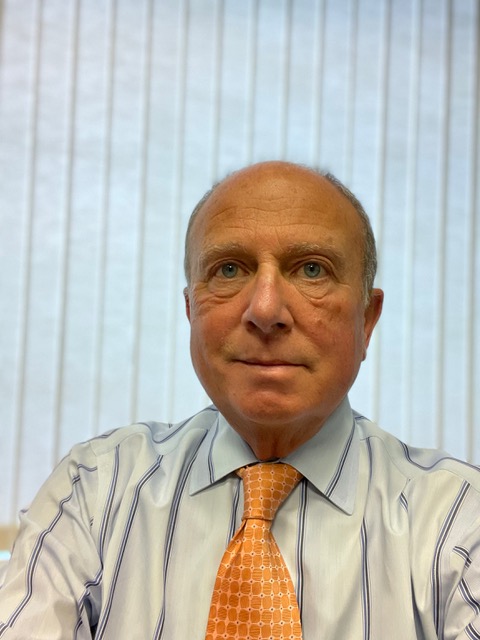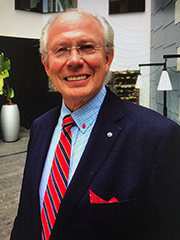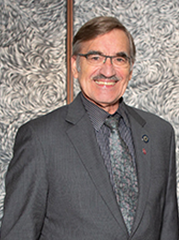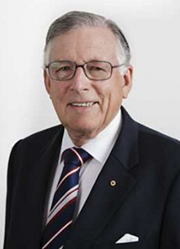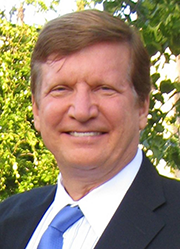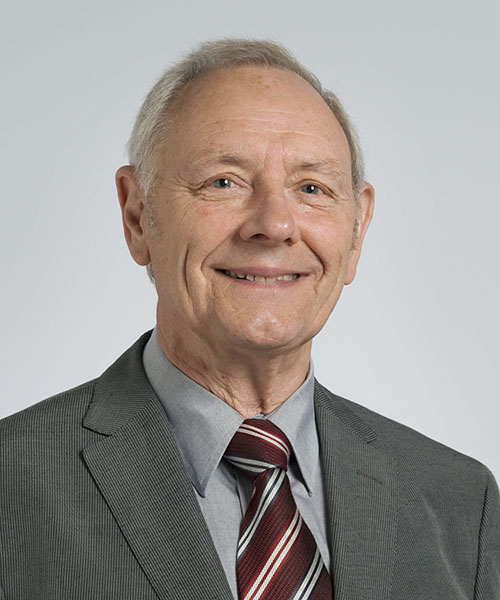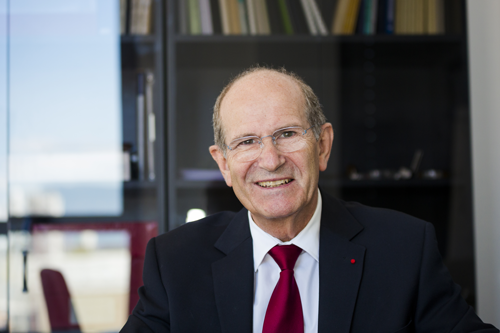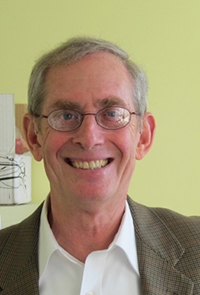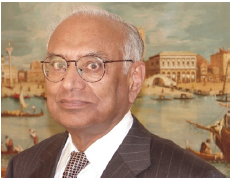Giants of Neuromodulation"If I have seen a little further, it is by standing on the shoulders of Giants." ‐ Sir Isaac Newton, 1676 The International Neuromodulation Society sees the importance of acknowledging the pioneers who laid its foundation and have made lifelong and significant contributions to improving the therapies, performing high quality clinical research and educating the rest of us. Toward that end, the INS began presenting the Giant in Neuromodulation Award to esteemed leaders in our field at each biennial congress starting in 2011. The award recognizes those whose lifetime work has brought neuromodulation to the people who need it.
2024 - Giancarlo Barolat, MD
Dr. Giancarlo Barolat
2022 - Bengt Linderoth, MD, PhD; and Robert Foreman, PhD Prof. Bengt Linderoth and Prof. Robert Foreman were named as recipients of the sixth Giant of Neuromodulation award in 2022, as part of the International Neuromodulation Society's 15th World Congress in Barcelona, Spain. During their scholarly careers, Prof. Linderoth and Prof. Foreman have developed a physiological understanding of the beneficial effects of pain treatment with spinal cord stimulation that goes far beyond the initial Gate Theory. Prof. Foreman is acknowledged for his monumental efforts in accumulating evidence for the therapy, and Prof. Linderoth for his great, often creative, work on elucidating the mechanisms of action. Through their scholarship and extensive collaboration within and outside the field, they have produced a body of impactful research that provides generations of clinicians, researchers, and engineers a deeper and more-detailed understanding of chronic pain and its treatment. Prof. Bengt Linderoth Prof. Linderoth is professor emeritus and former head of the Section of Functional Neurosurgery; and current faculty at the Department of Clinical Neuroscience, Karolinska Institutet in Stockholm, Sweden. He holds a position as adjunct professor of physiology at Oklahoma University Health Sciences Center and Hon. Prof. at the University of Maastricht NL (2015-2017). He has spent more than 30 years in full-time clinical neurosurgical practice and is still a part-time clinical consultant at the Karolinska Pain Center. He has been a member of the executive committee of the European Society for Stereotactic and Functional Neurosurgery; board of directors in the World Society (WSSFN) and is still a member of the editorial board of Neuromodulation, and has been editor of the Experimental Studies section in WIKISTIM since its inception. Prof. Linderoth has published more than 150 original research papers and contributed to more than 100 review articles and book chapters. His recent research interests and collaborations have spanned electrical CNS stimulation for severe pain and ischemia, "drug-enhanced SCS", DBS for Parkinson´s disease and tremor, neurocardiology, SCS for irritable bowel disease, percutaneous approaches to trigeminal neuralgia, and intracranial implantation of nerve growth factors in Alzheimer's and Parkinson's disease. This recent honor is just one of the many he has received throughout his career. Prof. Robert Foreman Prof. Foreman is George Lynn Cross Research Professor Emeritus in the Department of Physiology at the University of Oklahoma Health Sciences Center, where he chaired the Department of Physiology for 25 years. His research has focused on neuromodulation in animal models of visceral pain. He has published more than 230 articles in peer reviewed journals, contributed numerous book chapters and presented approximately 200 invited seminars worldwide. An early recipient of a Research Career Development Award from the National Heart, Lung, and Blood Institute, he received continuous research funding from the National Institutes of Health from 1975 to 2010. Prof. Foreman is past president of the North American Neuromodulation Society and past treasurer of the International Neuromodulation Society. In recent years, he received the Distinguished Service Award and the Lifetime Achievement Award from the North American Neuromodulation Society. He is Acting Editor-In-Chief and Section Editor of Basic Science for Neuromodulation: Technology at the Neural Interface. He has also served an executive board member of the Lynn Institute in Oklahoma City, OK.
2019 - Michael Cousins, MD DSc FANZCA FFPMANZCA FAChPM(RACP) FAICD; and Richard North, MD Prof. Michael Cousins and Dr. Richard North have been named as recipients of the International Neuromodulation Society’s fifth Giant of Neuromodulation Award in conjunction with the INS 14th World Congress in Sydney, Australia, in May 2019. Through their science, publications, teaching and education they have made a lasting contribution. This is the first time that the award acknowledges two very worthy recipients. Prof. Cousins and Dr. North have dedicated much of their long careers to improving the lives of people who live with chronic pain. Both proponents of evidence-based medicine, they have educated those within and outside of the field with their prolific, seminal publications, shaping how chronic pain is understood and treated. Prof. Michael CousinsAs president of the International Association for the Study of Pain (IASP), Prof. Cousins helped to forge an official relationship between the IASP and the World Health Organization (WHO). He also expanded its emphasis to cancer pain and acute pain, in addition to chronic pain. In Australia, Prof. Cousins was the founding president of the Australian Pain Society in 1979, and chaired the Joint Advisory Committee on Pain Medicine of several specialist colleges. That led to the formation of the Faculty of Pain Medicine (FPMANZCA) in 1999. That same year, he became founding dean of the Faculty of Pain Medicine at the Australian and New Zealand College of Anaesthetists (ANZCA), which has been unique worldwide in bringing together five specialty bodies to oversee a single training program and examination leading to a specialist qualification in pain medicine. His call to arms that chronic pain is a disease in its own right has transformed our approach globally. He has lead seminal research in intrathecal therapy and his neuromodulation work spans four decades. Dr. Richard NorthDr. North has been instrumental in the development of the field of neuromodulation with a career spanning more than 30 years. He has had a prodigious scientific output of more than 80 papers, with his first paper in the field published in 1977. His seminal article on spinal cord stimulation versus re-operation provided the scientific underpinning of clinical practice and is one of the most quoted papers in the field. At the Johns Hopkins University School of Medicine, he directed the Neurosurgery Spine Service for 16 years and co-directed the Division of Functional Neurosurgery. He was Professor of Neurosurgery, Anesthesiology and Critical Care Medicine at Johns Hopkins for 10 years, and a member of the full-time faculty for 25. The American Academy of Pain Medicine has recognized Dr. North’s research achievements and clinical expertise with the Academy’s prestigious Founder’s Award, and the North American Neuromodulation Society with its Lifetime Achievement Award. Dr. Richard North has served in various roles on the boards of the INS and North American Neuromodulation Society (NANS) for many years, and was NANS president in 2004 - 2005. He has played a significant role in the INS journal, Neuromodulation: Technology at the Neural Interface, to which he has generously contributed as an Editorial Board Member, advisor, and author since the journal’s inception. Dr. North is also the co-founder and president of The Neuromodulation Foundation, which is active in developing clinical trial designs and practice parameters, and produces WIKISTIM, a searchable website that displays the results of scientific research in the field of neuromodulation and encourages collaboration in the field.
2017 - Michael Stanton-Hicks, MBBS, Dr.Med.(Düs), FFARCS (FRCA), FCAI (HON), ABPM, FIPP Michael Stanton-Hicks, MBBS, Dr.Med.(Düs), FFARCS (FRCA), FCAI (HON), ABPM, FIPP, has been called a giant in the management of complex regional pain syndrome. This rare but debilitating condition is considered one of the best indications for neurostimulation. In 2017, the International Neuromodulation Society named him the fourth Giant of Neuromodulation, an honor that is publicly bestowed at the society’s biennial congress. "Dr. Stanton-Hicks is revered throughout the neuromodulation community," commented INS President Timothy Deer, MD. "Beneath his mild and gentlemanly demeanor is a deeply held passion and dedication to the field and the betterment of patients' lives. In a way, he was the right person in the right place at the right time. His extensive contributions have bridged simultaneous advances in neurostimulation and a growing understanding of chronic pain and complex regional pain syndrome." His interest in complex regional pain syndrome (CRPS) began in the 1970s. He completed postgraduate training in anesthesia in 1968, and joined the faculty of the University of Washington in 1970. The chairman of anesthesiology was Dr. John J. Bonica. A pioneer in pain medicine, Dr. Bonica had encountered many cases of CRPS I and II in the thousands of WWII veterans he treated from the Pacific Theater while he was chief of anesthesia at Madigan Army Hospital at Fort Lewis in Tacoma. Before leaving Washington in 1975, Dr. Stanton-Hicks met Dr. Yoshio Hosobuchi, a neurosurgeon who had done early work in the use of neurostimulation of the central nervous system for chronic pain. Dr. Stanton-Hicks gained more experience with neuromodulation in 1987 at the University of Mainz, where he had hands-on experience implanting infusion pumps. In 1988, he joined the Cleveland Clinic. There, worked for five years with Sam Hassenbusch, MD, and they undertook a large number of spinal and peripheral nerve stimulation procedures for chronic neuropathic and CRPS pain. Up until then, he said, CRPS had continued to be a large part of his endeavors: After leaving U of W, Dr. Robert Boas, a New Zealander, and I developed a multidisciplinary pain clinic—actually based on that which had been established by John Bonica in Washington—at the University of Massachusetts in Worcester. It was the first clinic of its kind in New England. There were a lot of CRPS patients. After 10 years, I assumed a position responsible for developing a multidisciplinary pain clinic at the Johannes Gutenberg University of Mainz in Germany, where, in 1988, the first meeting to discuss the problem of CRPS and its diagnosis was held. This was convened in a small castle, “Schloss Rettershof”. Some 30 clinicians and basic scientists of many disciplines deliberated on the taxonomy, criteria for diagnosis and how to advance this knowledge in different countries. We made our material available to the IASP, which was the starting point for establishing the Special Interest Group: Pain and the Sympathetic Nervous System and a series of subsequent scientific meetings that changed the name from reflex sympathetic dystrophy (RSD) to complex regional pain syndrome (CRPS). This catalyzed basic and clinical science around the world that is yielding enormous amounts of information regarding the nature of this condition—a pathophysiology that now includes autonomic dysfunction, immune dysfunction, autoimmunity, movement disorder, and probable genetic overtones. That period also produced new medical societies concerned with pain and neuromodulation. He recalled those origins: The North American Neuromodulation Society (NANS) actually began with two separate physician specialties, namely, neurosurgery and anesthesia/pain. With the therapeutic limitations of regional anesthesia, yet widespread familiarity with the entire spine and head and neck, anesthesiologists who worked with chronic pain patients rapidly took to the application of spinal cord stimulation that was much more effective on a long-term basis. Two anesthesiologists, Ballard Wright, MD and Barry Schwartz, MD had already formed a society they called “The Neuraxial Pain Society” in 1993. Shortly before, in 1989, the International Neuromodulation Society was formed by a group of neurosurgeons, neurologists, vascular medicine specialists and cardiologists. After being approached by Dr. Wright to join their society, Sam Hassenbusch, who was already in discussions with the new INS about forming an American chapter, and I set about organizing an initial meeting that would end up being the springboard for a nascent NANS. This was in 1994. I already had some experience in the development of two societies, the American Society of Regional Anesthesia and the World Institute of Pain, so I felt I was on familiar ground with NANS and for my sins I was elected its first president. It was probably the momentum gained through the earlier INS activity that carried through to keep everyone on target. Dr. Stanton-Hicks shifted from full staff to a consultant role at the Cleveland Clinic in 2011, helping guide a newer generation of clinicians with advice on patient care and the incorporation of neuromodulation and interventional therapies towards this goal. Looking ahead to the future of neuromodulation, he said he foresees an expansion of indications beyond pain, to include improvement in organ function and body systems. “Neuromodulation will become less invasive,” he predicted, “and will be increasingly targeted with the use of viral transport, stem cells and ontological approaches. Issues such as tolerance will disappear due to technological advances as our understanding of the central nervous system expands, the list of indications will grow, and the technical advances will expand exponentially.” He adds, “There is an increasingly strong argument for the utility of neuromodulation systems based on their cost-effectiveness and therapeutic efficacy that will transcend traditional pharmacological therapies.”
2015 - Professor Alim-Louis Benabid, MD, PhD The third International Neuromodulation Society Giant of Neuromodulation Award went to Alim-Louis Benabid, MD, PhD. Prof. Benabid, an emeritus professor of biophysics at Joseph Fourier University in Grenoble, discovered in 1987 that high-frequency direct brain stimulation reversibly mimics the effects of neurosurgical lesioning. That finding ushered in the current era of deep brain stimulation (DBS), benefitting some 100,000 patients who have Parkinson’s disease, essential tremor, or dystonia. DBS is now considered a gold standard for surgical treatment to control motor symptoms of movement disorder. It has largely replaced ablation due to being adjustable and reversible. New potential indications and stimulation targets are under investigation. In the U.S., DBS also has a humanitarian device exemption for obsessive compulsive disorder. Prof. Benabid was trained in functional neurosurgery and physics at Joseph Fourier University and now chairs the board of Clinatec - The Edmond J. Safra Biomedical Research Center in Grenoble. Looking back to his serendipitous discovery of the frequency effect of brain stimulation, he recalls stopping and apologizing during intraoperative probing in 1987 when his essential tremor patient’s involuntary movement suddenly stopped. He was concerned the calming effect might be due to muscle contraction caused by unintentionally stimulating the internal capsule. However, the patient could move his hand freely and remarked that this was the first time he had not had tremor in a long time. Upon continuing, Prof. Benabid saw the effect recurred. Prof. Benabid had set out to methodically and slowly increase stimulation levels in this case, stepping up through the range of frequencies offered by his intraoperative probe. He was surprised to observe that higher frequencies of about 100 Hz inhibited a motor response, since the lower frequencies of 30 – 50 Hz typically used during intraoperative probing were, by contrast, excitatory. In the back of his mind, he had always hoped that a reversible therapy might be found to replace ablation, which had been the only surgical option for patients with movement disorder for years. Deep brain stimulation systems had already been introduced as an intervention for deafferentation pain. Since these implant systems already existed, Prof. Benabid sought permission to offer DBS when movement disorder patients were referred for a second thalamotomy, reasoning that the reversible approach of DBS might pose lower risks than bilateral ablation. DBS is now predominantly preferred over ablation to manage motor symptoms for eligible patients with Parkinson’s disease or essential tremor. Both the technology and exact stimulation targets have been refined over recent decades. Even today, research into optimal approaches continues. One of Prof. Benabid’s most recent recognitions has been the Lifetime Achievement award from the North American Neuromodulation Society in December 2014. In September 2014, he shared the $250,000 Lasker award with Mahlon DeLong, MD, professor of neurology at Emory University School of Medicine. In France, along with neurologist Pierre Pollak, MD, Prof. Benabid built upon preclinical work published by Prof. DeLong in 1990, and undertook clinical study of high-frequency stimulation of the subthalamic nucleus in Parkinson’s disease patients, publishing those results in 1993. Prof. Benabid was elected to the French Legion of Honor in 2002, the same year DBS was approved in the U.S. for advanced symptoms of Parkinson’s disease. In the fall of 2014, he received a $3 million Life Sciences award from the Breakthrough Prize Foundation in Silicon Valley for his work in developing DBS and its impact on the treatment of Parkinson’s disease. In 2013, he devoted a $100,000 Robert A. Pritsker Prize from the Michael J. Fox Foundation to spur research at Clinatec - The Edmond J. Safra Biomedical Research Center in Grenoble. He had become board chairman there in 2009, after reaching official retirement age as professor of biophysics at Joseph Fourier University, where he remains an emeritus professor who can supervise work of doctoral students. Not only does he retain an avid interest in unfolding knowledge about the frequency effects of neurostimulation, but he also continues to look ahead, recently presenting to the French Academy of Sciences, for instance, research into the use of near-infrared light as a neuroprotective influence on dopaminergic neurons.
2013 - Elliot Krames, MDThe second International Neuromodulation Society Giant of Neuromodulation Award went to Elliot Krames, MD, and was announced in a news release after the ceremony. From the 11th World Congress program: Dr. Elliot Krames is one to admit he has passion when he delves into a subject, and lucky for us, early in his career, he had a passion for the burgeoning field of neuromodulation. He is the founder and emeritus editor-in-chief of Neuromodulation: Technology at the Neural Interface, a past president of INS, and former board member of the North American Neuromodulation Society, the American Academy of Pain Medicine, the American Board of Pain Medicine and the World Institute of Pain. Three times he chaired or co-chaired our World Congresses, and three more times – including this year – he organized and chaired major components of the overall meeting. He co-authored “Pain Medicine, Tools of the Trade” and “Operative Neuromodulation”, has authored or coauthored more than 80 publications and has spoken world wide more than 350 times. In 2009, with Drs. Hunter Peckham and Ali Rezai, he co-edited the two-volume text “Neuromodulation”. Without Elliot’s vision, we may not have had a journal so soon or an early laser focus on establishing the scientific credibility for a field that by its nature is not amenable to the more traditional path of large, randomized, double-blind controlled trials typical in pharmaceutical development. So, Elliot brought his considerable energy to bear on not only establishing a multi-site practice, advancing pain intervention techniques, and treating patients, but also to help others to perfect their skills, their understanding, and their access to care through his impact and his influence on important stakeholders whose reimbursement or investment helps to fuel these medical device advances. With an MD from the University of Maryland Medical School in 1971, he completed his residency in Anesthesiology and fellowship in Obstetrical Anesthesiology at the University of California, San Francisco in 1974. As he recounted in an article last summer in our journal, he developed a clinical interest in the use of intrathecal morphine, first for women in labor and shortly thereafter, for cancer patients who had intractable pain. As a pioneer in pain intervention, Dr. Krames was the first Director of Cancer Pain Management at Mt. Zion Hospital in San Francisco from 1983-1987 and launched the Pacific Pain Treatment Center, since then, a private interdisciplinary pain practice where he consults and was medical director until earlier this year – several years beyond the age many of us might wish to retire. However, rather than retire, Dr. Krames is turning to a second passion – his 300-acre ranch of wine grapes in the foothills of California. He said he developed that passion around the same time he was discovering the wonders of intrathecal morphine in pain management – as a medical intern arriving for the first time in California and discovering the taste of something beyond the sweet Passover wine he grew up with on the East Coast. Perhaps due to his passions being somewhat intertwined it is not a surprise it was a patient who introduced Elliot to his region of retirement, a spot where for the past dozen years or so he, his lovely wife Rosellen, their tight-knit family, and a small crew have been patiently tending their crop and transforming the harvest in a collaboration with a winemaker into a memorable creation to savor. Like his wines, Elliot’s many publications, books, invited talks, and leadership roles leave a lasting impact, helping to shape what our field has become – and we are the better for it. 2011 - Krishna Kumar, MD
The first International Neuromodulation Society Giant in Neuromodulation Award was bestowed upon Krishna Kumar, MD, Clinical Professor of Neurosurgery at the University of Saskatchewan, College of Medicine, and the founding President of the Canadian Neuromodulation Society. His medical career spanned more than 50 years, until his death April 13, 2014 at age 83. Extraordinarily dedicated to improving the lives of those suffering from chronic pain and movement disorders, Dr. Kumar was renowned for his work as a clinical professor, researcher in neurosurgery and visionary in brain and spinal neuromodulation. He was recalled in an editorial in Neuromodulation: Technology at the Neural Interface by Editor-in-Chief Robert Levy, MD, PhD as not only someone of quiet but immeasurable accomplishment, but also as a dedicated, hard-working, modest and respectful friend and colleague who was devoted to his family, a tireless advocate for his patients, and showed a gracious spirit to all.

|
||||
| Last Updated on Thursday, March 28, 2024 08:52 PM |

